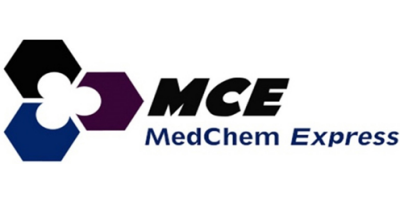

MedChemExpress - Model THZ1 - 1604810-83-4
THZ1 is a selective and potent covalent CDK7 inhibitor with an IC50 of 3.2 nM. THZ1 also inhibits the closely related kinases CDK12 and CDK13 and downregulates MYC expression[1][2].MCE products for research use only. We do not sell to patients.
THZ1
MCE China:THZ1
Brand:MedChemExpress (MCE)
Cat. No.HY-80013
CAS:1604810-83-4
Purity:98.03%
Storage:Powder -20°C 3 years 4°C 2 years In solvent -80°C 6 months -20°C 1 month
Shipping:Room temperature in continental US; may vary elsewhere.
Description:THZ1 is a selective and potent covalent CDK7 inhibitor with an IC50 of 3.2 nM. THZ1 also inhibits the closely related kinases CDK12 and CDK13 and downregulates MYC expression.
In Vitro:THZ1 inhibits Jurkat cell and Loucy cell with IC50 of 50 nM, and 0.55 nM, respectively. THZ1 (9, 27, 83, 250, 750, and 2500 nM) inhibits CDK12 but at higher concentrations compared to CDK7. THZ1 (1 μM) irreversibly inhibits RNAPII CTD and CAK phosphorylation. THZ1 (2.5 μM) irreversibly inhibits RNAPII CTD phosphorylation by covalently targeting a unique cysteine located outside the kinase domain of CDK7 in Hela S3 cells. THZ1 (250 nM) causes decreased cellular proliferation and an increase in apoptotic index with concomitant reduction in anti-apoptotic proteins, most notably MCL-1 and XIAP in T-ALL cell lines[1]. All genotypically-distinct human (hSCLC) cell lines exhibit high sensitivity to THZ1, with an IC50 in the range of 5-20 nM[3].
In Vivo:THZ1 (10 mg/kg) demonstrates potent killing of primary chronic lymphocytic leukemia (CLL) cells and anti-proliferative activity against primary TALL cells and in vivo against a human T-ALL xenograft[1]. THZ1 (10 mg/kg, i.v.) inhibits tumor growth in a mouse model of human MYCN-amplified NB and shows no toxicity[4]. THZ1 (10 mg/kg, i.p.) completely suppresses oesophageal squamous cell carcinoma tumour growth in vivo without loss of body weight or other common toxic effects[5].
Animal Administration:Mice[1] Thirty-two NOD-SCIDIL2Rcγnull (NSG) 9-week old female mice are divided into treatment groups based on mean BLI as follows: THZ1 10 mg/kg qD, THZ1 10 mg/kg BID, and vehicle (10% DMSO in D5W) BID (n=10 for all groups). Two mice are excluded, one with the highest and one with the lowest BLI. All treatments are administered via IV injection in the lateral tail vein in a volume of 3.3 μL/g (non-blinded). Mice are imaged and weighed every 3-5 days. Mice are treated for four weeks and on the final day mice are imaged, dosed and sacrificed approximately 5-6 hrs post dose. Upon sacrifice, blood is collected via cardiac puncture in EDTA tubes; a portion (300 uL) is processed for plasma. Liver and spleen tissues are collected from each mouse with half of each sample flash frozen and half of each sample fixed. Blood plasma and liver samples are processed for pharmacokinetics analysis of THZ1. Spleen tissues are homogenized and lysed and processed for pharmacodynamics analysis of THZ1 target engagement.
Cell Assay:Jurkat, Loucy, KOPTK1, and DND-41 cell lines are seeded in 384-well microplates at 15% confluency in medium. Cells are treated with THZ1 (2, 10, 50, 250, 1250, and 6250 nM) or DMSO for 72 hrs and cell viability is determined using resazurin[1].
IC50 & Target:CDK7 3.2 nM (IC50) CDK12 CDK13
Hot selling product:Dihydrotanshinone I | Creatinine | Uracil | Posaconazole-d5 | Levalbuterol (hydrochloride) | PLX7904 | EACC | Gum guaiac | Pinaverium bromide | Ginsenoside Re
Trending products:Recombinant Proteins | Bioactive Screening Libraries | Natural Products | Fluorescent Dye | PROTAC | Isotope-Labeled Compounds | Oligonucleotides
References:
[1]. Kwiatkowski N, et al. Targeting transcription regulation in cancer with a covalent CDK7 inhibitor. Nature. 2014 Jul 31;511(7511):616-20. [Content Brief]
[2]. Zeng M, et al. Targeting MYC dependency in ovarian cancer through inhibition of CDK7 and CDK12/13. Elife. 2018 Nov 13;7. pii: e39030. [Content Brief]
[3]. Christensen CL, et al. Targeting transcriptional addictions in small cell lung cancer with a covalent CDK7 inhibitor. Cancer Cell. 2014 Dec 8;26(6):909-22. [Content Brief]
[4]. Chipumuro, et al. CDK7 inhibition suppresses super-enhancer-linked oncogenic transcription in MYCN-driven cancer. Cell. 2014 Nov 20;159(5):1126-39. ? [Content Brief]
[5]. Jiang YY, et al. Targeting super-enhancer-associated oncogenes in oesophageal squamous cell carcinoma. Gut. 2016 May 10. pii: gutjnl-2016-311818. [Content Brief]
Brand introduction:
• MCE (MedChemExpress) has a global exclusive compound library of more than 200 kinds, and we are committed to providing the most comprehensive range of high-quality small molecule active compounds for scientific research customers around the world;
• More than 50,000 highly selective inhibitors and agonists are involved in various popular signaling pathways and disease areas;
• The products cover a variety of recombinant proteins, peptides, commonly used kits, more PROTAC, ADC and other characteristic products, widely used in new drug research and development, life science and other scientific research projects;
• Provide virtual screening, ion channel screening, metabolomics analysis detection analysis, drug screening and other professional technical services;
• It has a professional experimental center and strict quality control and verification system;
• Provide LC/MS, NMR, HPLC, chiral analysis, elemental analysis and other quality inspection reports to ensure the high purity and high quality of products;
• The biological activity of the products has been verified by the experiments of customers in various countries;
• A variety of top journals such as Nature, Cell, Science and pharmaceutical patents have included the scientific research results of MCE customers;
• Our professional team tracks the latest pharmaceutical and life science research and provides you with the latest active compounds in the world;
• It has established long-term cooperation with the world's major pharmaceutical companies and well-known scientific research institutions。
